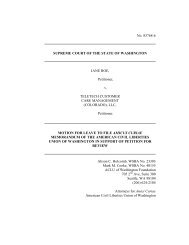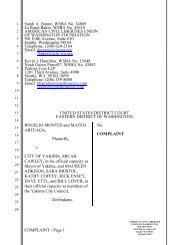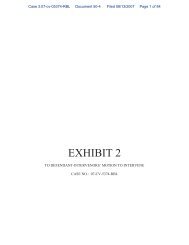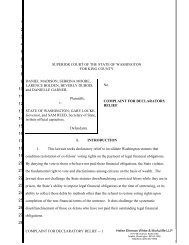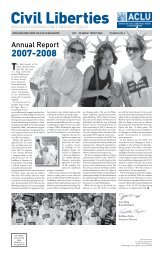BERGER v. CITY OF SEATTLE - ACLU of Washington
BERGER v. CITY OF SEATTLE - ACLU of Washington
BERGER v. CITY OF SEATTLE - ACLU of Washington
You also want an ePaper? Increase the reach of your titles
YUMPU automatically turns print PDFs into web optimized ePapers that Google loves.
264 <strong>BERGER</strong> v. <strong>CITY</strong> <strong>OF</strong> <strong>SEATTLE</strong><br />
tural Ass’n, 387 F.3d 850, 861 n. 10 (9th Cir. 2004), explaining<br />
that patrons <strong>of</strong> a “place <strong>of</strong> public entertainment” were not<br />
a captive audience as in Madsen and its progeny, because they<br />
were obviously not “particularly vulnerable,” as are the<br />
patients and doctors in such cases.<br />
The majority nonetheless asserts that the First Amendment<br />
rights to intimate and expressive association recognized by<br />
Boy Scouts <strong>of</strong> America v. Dale, 530 U.S. 640 (2000) and Roberts<br />
v. United States Jaycees, 468 U.S. 609 (1984) justify similar<br />
protections to those at issue in the Madsen line <strong>of</strong> cases.<br />
Maj. Op. at 242 n. 35. This argument is both rife with error<br />
and blind to the role <strong>of</strong> public parks as a location for interchange<br />
among citizens.<br />
First, it is not at all clear that people “wishing to exercise<br />
their interest in private and public expression <strong>of</strong> individuals in<br />
intimate association with family and friends at a picnic,” as<br />
the majority puts it, even implicate the rights at issue in Dale<br />
and Roberts. Those cases concern two sorts <strong>of</strong> association:<br />
“Certain intimate human relationships,” Roberts, 468 U.S. at<br />
618, and expressive association “for the purpose <strong>of</strong> engaging<br />
in those activities protected by the First Amendment.” Id.; see<br />
also Dale, 530 U.S. at 647-48. 15 Picnickers do not fall naturally<br />
into either category (the majority appears to be melding<br />
the two when it refers to the “expression <strong>of</strong> individuals in intimate<br />
association”) unless Dale and Roberts are far more<br />
sweeping than they have previously been understood to be.<br />
Second, the flat ban on communication at the Seattle Center<br />
is more extreme than the restrictions considered in the Madsen<br />
line <strong>of</strong> cases. In those cases, unlike here, there was a history<br />
<strong>of</strong> aggression justifying some speech restrictions. See<br />
15 It is also worth noting that neither Roberts nor Dale are concerned<br />
with protecting such associations from other private parties but instead<br />
deal with “undue intrusions by the State.” Roberts, 468 U.S. at 618; see<br />
also Dale, 530 U.S. at 647-48.




